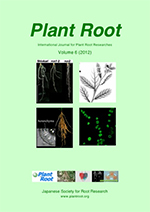The identification of genetic factors affecting deep root systems is needed to improve adaptability to drought stress. In wheat (Triticum aestivum L.), seminal root angle (SRA), which can be easily measured at the seedling stage, is a useful proxy for understanding the mature root system architecture. In the present study, we attempted to find a genetic variation in the vertical distribution of seminal roots and to determine chromosomal positions involved in a variation of SRA using ditelosomic (Dt) lines and deletion lines of wheat cultivar Chinese Spring (CS). SRA of CS and 31 Dt lines were estimated in a pot experiment using the basket method. When SRA was measured separately for the primary, first pair, and second pair of seminal roots, it was found that the genetic variation was the largest in the first pair of seminal roots followed by the second pair of seminal roots. In contrast, there were no genetic differences in the SRA of the primary root between the CS and CS Dt lines. Compared to CS, which had a small SRA, Dt5BL, Dt6AS, Dt6BS, and Dt6DS displayed significantly larger SRA, indicating that the deficient chromosome arms 5BS, 6AL, 6BL, and 6DL appeared to carry quantitative trait loci (QTLs) affecting SRA. Furthermore, the terminal regions of chromosome arms 6AL and 6BL were found to carry QTLs responsible for a small SRA. Using the QTLs information obtained in this study, novel genes may be isolated from wheat.
View full abstract
